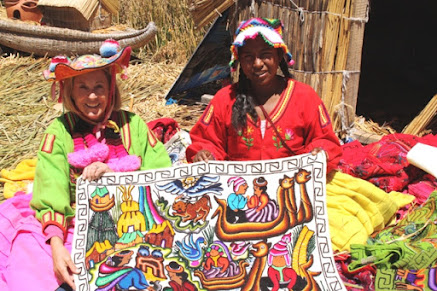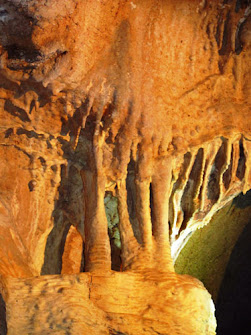Peru is known for its world-class folk art.
From pre-Inca times to
the present day, handmade arts and crafts have
provided a visual expression of Peruvian culture. The nation’s skilled artisans
have forged one of the most highly developed and diverse folk art traditions in
the world, working in a variety of mediums and styles.
Pre-Hispanic designs and symbols often fused with art forms from colonial Spain in works of art as beautiful as they are utilitarian. From quirky masks to complex woven textiles, from hand-painted pottery to intricately carved gourds, from hand-crafted instruments to elaborate wood carvings, Peru’s distinctive handicrafts are an excellent way to bring home an authentic reminder of the country’s vibrant traditions and culture.
This is the first of a two-part story about different kinds of Peruvian handmade crafts.
 |
| Hand-woven textiles are an ancient art. |
Beautiful hand-woven
textiles are among Peru’s most famous native crafts. They’re also among the
most ancient: The oldest fabrics discovered in the country date to about 10,000
B.C. Using traditional backstrap or horizontal ground looms just like their
ancestors, artisans today weave fibers of prized alpaca and vicuña wool, as
well as cotton and linen, into colorful designs that reflect local customs and
motifs. Bold, bright designs range from intricate geometric patterns to revered
native animals, which show up in yards of fabric that you can buy as
tablecloths, table runners, placemats, rugs, tapestries, and blankets.
Alpaca WoolHighlands people tend their llama flocks.
Hardly anyone leaves
Peru without buying something made of alpaca wool such as sweaters,
hats, tote bags, super-soft scarves, and traditional ponchos and blankets.
After all, these Andean camelids have been a key part of Peruvian life for
centuries. Lightweight, breathable, and hypoallergenic, alpaca is insulating
and non-itchy. Baby alpaca items, made from the fleece of the first shearing,
is supremely soft. Rarer and softer still — with a price tag to match — is
the ultrafine wool of wild vicuñas, from which alpacas are descended.
 |
| Larry bought an alpaca sweater, and I have a soft creamy vest. |
EmbroideryColorful yarns are used in hand embroidery on garments and home accents.
Another millennia-old
fabric tradition is hand embroidery, which often served ceremonial purposes in
ancient times. Today, it reflects the cultural identity of each region or
village, which has its own unique style. You’ll find vibrant, patterned
embroidery on local women’s skirts, handbags, men’s vests, jackets, and other
traditional garments. Pillowcases with brightly colored floral accents or elaborate
wall hangings stitched with scenes from daily life add a pop of color to your
home. Known as bordados, these hand-dyed, alpaca-yarn narratives are
embroidered on a wool cloth background.
Appliqué FabricI have this amazing wall hanging that depicts scenes from
daily lives of people living on the floating islands of Uros.
Gorgeous wall hangings
of another sort are Peru’s distinctive quilted appliqués on cotton fabric
called arpilleras (meaning "sackcloth" or
"burlap"). These hand-stitched, three-dimensional patchwork panels
typically depict pastoral scenes of daily life, such as villages, markets,
landscapes, or carnivals. Two biblical themes, Noah’s ark — with requisite
llamas— and nativity scenes are also popular. The women who make these
elaborate tapestries attach scraps of fabric including vinyl, felt, or straw
fibers to the cloth background to tell the stories of their lives.
Wood CarvingsI love this colorful puzzle from Peru.
From religious
figurines and masks to portable altars and toys, Peru has a rich wood-carving
tradition derived from Spanish religious sculptures and carved furniture made
for colonial churches and convents. In Cusco, expert sculptors carve classical
religious figures such as the infant Jesus, angels, and Virgins that are often
gold-leafed, as well as kings, magicians, dancers, and soldiers. In the town of
Molinos, near Huancayo, artisans make a variety of wooden objects from kitchen
utensils and toys, painted animals, and mythical beasts. In folklore-rich towns
like Paucartambo in the Cusco region and Puno, on the shore of Lake Titicaca,
elaborate carved and painted masks of fanciful creatures and stylized
characters are produced for popular festival days.
Retablos
The most remarkable of
Peru’s wooden folk art are its unique brightly painted retablos, or small
portable altars. Originally used by Spanish priests to teach indigenous people
about the Bible, these colorful diorama-like boxes depict everything from
intricate religious or historical scenes to simple scenes of everyday life in
the Andes. Originating in Ayacucho, the boxes are elaborately hand-painted with
typical Ayacucho flower designs adorning their hinged flaps. Inside the boxes,
artists fill multiple levels with hand-carved figurines of people, highland
animals, and both Christian saints and pre-Columbian gods, a unique blend of
religious traditions. Typically, the upper level symbolizes heaven with saints,
sacred Andean animals, or nativity scenes, while the lower level portrays life
on earth, such as a hat shop, a cantina, or a musical group.
Information courtesy of Angela Tuell, Percepture, atuell@percepture.com
Photos by Larry and Beverly Burmeier and free sources.























